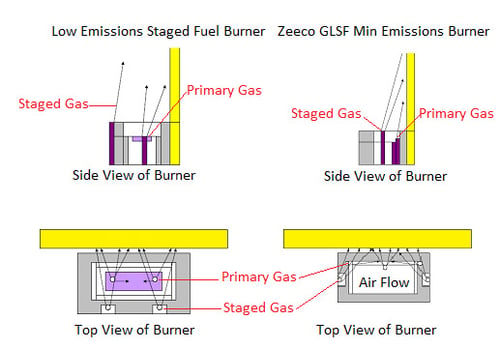欧洲乙烯生产商会议研讨会
在乙烯裂解应用中,火焰滚燃和火焰相互作用可能是个问题。火焰滚燃问题会导致火焰撞击炉管,产生热点。炉管内的这种局部高温会导致过早炼焦,并缩短脱焦和乙烯产量降低之间的间隔时间。自 21世纪初起,柘科和惠生工程有限公司在许多改造应用中进行了合作,在这些应用中,地面燃烧器的数量增加,燃烧器之间的间距必须移近。即使在这种情况下,使用正确的技术也有助于避免火焰滚燃和相互作用等问题的发生。
Abstract
Burner retrofits in Ethylene cracking applications have proven to be challenging projects due to burner spacing requirements and resulting effects upon burner flame quality. As existing furnaces are upgraded to achieve higher capacities, more floor burners are added resulting in smaller distances between burners and more potential for adverse flame conditions such as burner-to-burner flame interaction and flame rollover.
Zeeco has developed a patented ultra low NOx burner technology, the ZEECO® GLSF Min-Emissions Enhanced Jet Flat Flame Burner, that provides not only a very small mechanical footprint, but also produces a flame profile with very limited burner-to-burner, flame-to-flame interaction and no flame roll-over.
Flame interaction between burners can cause flame impingement upon the process tubes and increased emissions. Flame impingement can also be problematic for prolonged Ethylene production, resulting in shorter run lengths and higher tube metal temperatures. An inherent design aspect of the GLSF Flat Flame Burner is the fact that the fuel gas is introduced between the furnace wall and the air stream. Consequently, flame interaction between burners is minimized due to the location of the burner tip and the very compact design. Since the gas does not cross the air stream, the tip drilling design can be modified to achieve better heat flux profiles without adversely effecting the thermal NOx emissions.
One of the other primary concerns for the end user operating company is flame rollover. When the momentum of the hot gases moving upwards from the burner becomes less than the momentum of the colder gases moving down the furnace tubes, flame rollover occurs. We will review the design details and advantages of the GLSF burner, provide specific retrofit installation details, lessons learned during the retrofit, and include results for several of the retrofit applications.
Comparison to Low Emissions Burners
Low emission burners found in ethylene cracking units typically use staged fuel technology. These particular burners have staged fuel tips strategically positioned for fuel to exit the orifices and pass over the combustion air stream before reaching the wall. In order to modify the flame pattern to achieve an even heat flux in the lower portions of the flame envelope, the orifices must be drilled at increasingly abrupt angles toward the furnace wall. These orifice angles cause the air and fuel gas to mix at a faster rate, thus increasing thermal NOx, and requiring a compromise between the heat flux profile and thermal NOx production. As the heat flux profile is made more uniform, with an average above 90%, the NOx emissions typically increase along with the increase in flux percentage. In the same respect, as the NOx is decreased, the heat flux percentage is also decreased.

总结
Wison has retrofitted many ethylene cracking furnaces with Zeeco GLSF Min-Emissions Burners to achieve challenging flame requirements. Even though the burners were mounted closely together, they showed no signs of flame interaction or flame rollover. The compact burner design allowed more burners to be installed more closely together without adversely affecting flame behavior. The GLSF Min-Emissions burner design has been used in over 140 challenging ethylene cracking furnaces, some of which with NOx emissions guarantees less than 90 mg/Nm3.
下载技术文件